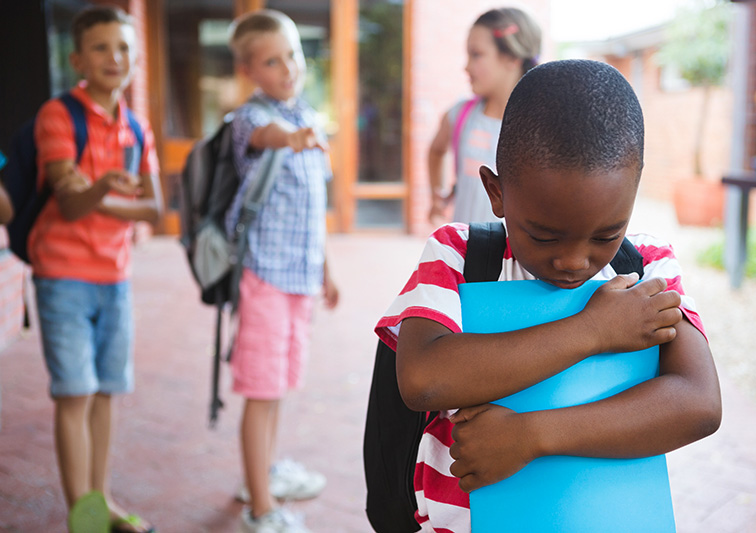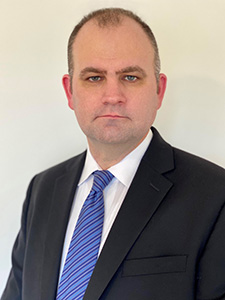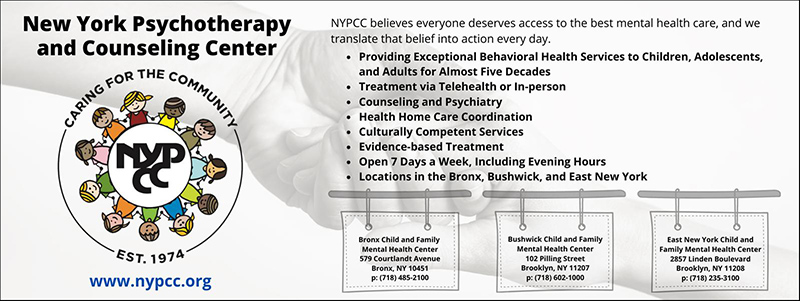As the largest mental health clinic provider in the South Bronx, New York Psychotherapy and Counseling Center (NYPCC) therapists have witnessed an influx of traumatized children struggling with bullying in city schools. Indeed, New York State Education Department statistics show that bullying is a significant problem in NYC public schools. During the 2017-18 academic year, NYC public schools reported 5,875 incidents of harassment, discrimination and bullying and 1,242 incidents of cyberbullying. The most recent data available from the State Education Department confirms that bullying in NYC public schools is on the rise. In the 2019-20 academic year, there were a record-high 8,475 incidents of harassment, discrimination, and bullying, as well as 1,864 cyberbullying incidents (NYSED, 2020). These statistics may be an underrepresentation of the issue, as the National Center for Education Statistics (2021) reported that 22% of students aged 12-18 faced bullying at school during the 2019 school year.

Bullying involves unwanted, aggressive behavior among school-aged children (U.S. Department of Health and Human Services, n.d.). To be considered bullying, the behavior must be repeated, or have the potential to be repeated. The bullying must also involve a real or perceived power imbalance between the child who bullies and the child who is bullied. Bullying activities can include spreading rumors or embarrassing a child to hurt their reputation or social standing, making threats of violence, physical or verbal assaults, or purposely excluding a child from a group.

Jonathan Keigher, PhD
Bullying affects the physical and emotional well-being of both the targets of bullying and those who engage in bullying behavior. According to the Centers for Disease Control and Prevention (2019), students who are bullied are at increased risk for social and emotional distress, self-harm, depression, anxiety, sleep problems, lower academic achievement, and dropping out of school. Bullied students have decreased academic performance and school participation. Students who bully are more likely to engage in violent or risky behaviors into adulthood. Markota et al. (2018) even found that ongoing bullying is significantly associated with increased rates of pediatric psychiatric rehospitalizations. Bullying also has long-lasting mental health outcomes. Many adults still experience the mental impact of having been bullied as a child, even decades after the bullying (Takizawa et al., 2014).
At NYPCC, clinicians approach bullying through a trauma-informed lens, recognizing that bullying impacts everyone involved in the bullying experience. During intake, therapists use evidence-based, culturally responsive assessments to evaluate all clients for traumatic exposure at the individual, family, and community levels. Therapists help the client establish physical and emotional safety and collaborate with family and community members to foster partnerships that are safe and supportive. Therapeutic interventions frequently focus on promoting social-emotional growth and building mental health supports to counter the isolation caused by bullying and other traumatic experiences. Therapists help build resiliency, empower clients to make thought out choices and instill hope. Self-regulation and social skills are practiced with an emphasis on empathy, assertiveness, and problem solving as the building blocks for bullying prevention.
NYPCC recognizes the complex impact trauma has on both patients and providers. All NYPCC therapists who treat bullying and other traumas do so under supervision that is based on the principles of recovery, mindfulness, and trauma-responsive care. Key elements of clinical supervision at NYPCC are ensuring workforce safety and promoting therapist resilience. Supervisors support clinicians to prevent re-traumatization by recognizing early signs of compassion fatigue and secondary traumatic stress. This maintains our workforce’s effectiveness and helps retain the talent needed to care for the community.
Given the effectiveness of systems-level interventions and the need to target the social contexts of bullying to reduce bullying behaviors, NYPCC founded the Bronx Anti-Bullying Coalition to engage the community in anti-bullying education and prevention efforts using a trauma-informed approach. NYPCC established the Bronx Anti-Bullying Coalition in 2018 in conjunction with Bronx Legal Services, Union Community Health Center, Vibrant Emotional Health, and Destination Tomorrow. The Bronx Anti-Bullying Coalition was launched to create awareness of the signs of bullying, help children and parents learn strategies to deal with the problem, and connect families with support resources. NYPCC’s community outreach team led group meetings and discussions with community partners to create a series of safe havens for children who have been bullied throughout NYC. Parents, educators, and clinicians learned how they could help raise awareness about the dangers of bullying and effectively intervene to stop bullying. NYPCC’s outreach team utilized a trauma-informed framework to promote childhood trauma awareness and to increase understanding of how trauma affects children’s learning and behavior. The outreach team helped to strengthen the resilience and protective factors within families, schools, and communities and pushed for meaningful collaboration across healthcare and school systems. NYPCC raised bullying awareness and streamlined access to resources on trauma exposure, its impact and treatment for teachers, principals, guidance counselors, clergy, parents, and community leaders. NYPCC’s clinicians and outreach team identified bullying as a significant problem for our clients and for the larger community we serve. NYPCC’s anti-bullying coalition responded with a trauma-informed approach to meet community needs with education, prevention, assessment, and treatment options.
Jonathan Keigher, PhD, is Vice President, Chief Clinical and Compliance Officer at the New York Psychotherapy and Counseling Center (NYPCC).
References
Centers for Disease Control and Prevention (2019). Preventing Bullying. Retrieved from Centers for Disease Control: https://www.cdc.gov/violenceprevention/pdf/yv/bullying-factsheet508.pdf
Markota, M, McKean, A.J., Romanowicz, M, Schak, K.M., Croarkin, P.E., & Vande Voort, J.L. (2018). Rehospitalization to a child and adolescent psychiatry unit: Role of trauma and bullying, General Hospital Psychiatry, 55, 10-14.
National Center for Education Statistics (2021). Bullying at School and Electronic Bullying, Retrieved from National Center for Education Statistics: https://nces.ed.gov/programs/coe/indicator/a10
NYSED (2020). School Safety and the Educational Climate. (2020 SSEC NYC) [Data set]. http://www.p12.nysed.gov/irs/school_safety/2020_SSEC_NYC.xlsx
Takizawa R, Maughan B, & Arseneault L. (2014). Adult health outcomes of childhood bullying victimization: evidence from a five-decade longitudinal British birth cohort. American Journal of Psychiatry, 171(7), 777-84. https://doi.org/10.1176/appi.ajp.2014.13101401
U.S. Department of Health and Human Services (n.d.). What Is Bullying. StopBullying.gov. https://www.stopbullying.gov/bullying/what-is-bullying




